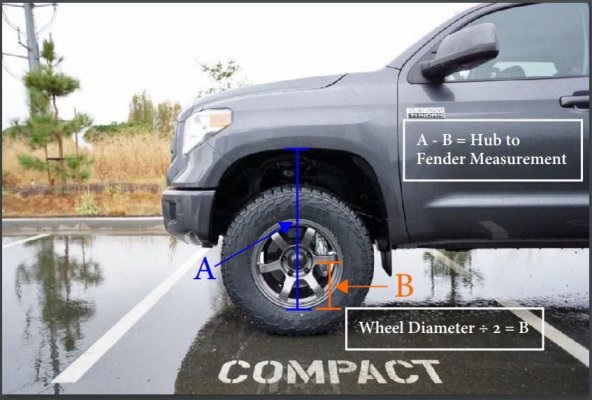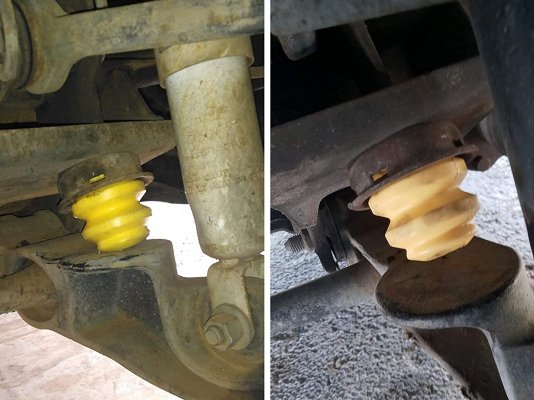I'm new to my Tahoe, so I'm not sure if I'm getting the terminology right, so bear with me and correct as necessary.
I noticed that the passenger's side front corner was lower than the driver's side. I thought maybe it had some accident damage, but when I got under the truck, I noticed that there are 2 bars running aft from the front to about under the 2nd row seats. At the end of the bars is a teardrop shaped plate, with a bolt running vertically, and the head of the bolt facing the ground. The passenger's side bolt was run out much farther than the other. It had a little over an inch of threads showing and the driver's side bolt had about a 1/4" of threads showing. I jacked up the truck, so the passenger's front tire was off the ground and then drove the corresponding bolt to roughly the same spot as the other one. After I let the truck down, the front seemed to be pretty level. So, I'm guessing these are the torsion bars, but correct me if I'm wrong. On the test drive, I noticed that the truck didn't pull at all, but the steering wheel is a few degrees off center. If I let go of the steering wheel and let it center out, the truck doesn't pull to either side, but the steering wheel isn't perfectly centered. I'm not sure if it was this way before and I just didn't notice or if it has something to do with the adjustment I made. Also, the spacing between the front fenders and the top of the tires seems a bit much, like the front end is a little high, but I don't actually know what it's supposed to be.
So here are my questions:
-Is that the right way to make the adjustment, lifting the corresponding front tire off the ground, adjust the bolt and let the truck down?
-Is there some way to make an accurate measurement to know that both sides are exactly the same? Fender to the top of the tire doesn't seem very accurate, with fender fitment and tire tread being variable. There should be some other part of the truck to measure with that's consistently accurate for both sides.
-Once the proper measuring points are determined, what exactly should that measurement be, considering that everything is stock, including tire size.
-Is the steering wheel being off center because the adjustment between the 2 sides isn't perfectly equal, or does it have to be something unrelated?
Thanks for the help.
I noticed that the passenger's side front corner was lower than the driver's side. I thought maybe it had some accident damage, but when I got under the truck, I noticed that there are 2 bars running aft from the front to about under the 2nd row seats. At the end of the bars is a teardrop shaped plate, with a bolt running vertically, and the head of the bolt facing the ground. The passenger's side bolt was run out much farther than the other. It had a little over an inch of threads showing and the driver's side bolt had about a 1/4" of threads showing. I jacked up the truck, so the passenger's front tire was off the ground and then drove the corresponding bolt to roughly the same spot as the other one. After I let the truck down, the front seemed to be pretty level. So, I'm guessing these are the torsion bars, but correct me if I'm wrong. On the test drive, I noticed that the truck didn't pull at all, but the steering wheel is a few degrees off center. If I let go of the steering wheel and let it center out, the truck doesn't pull to either side, but the steering wheel isn't perfectly centered. I'm not sure if it was this way before and I just didn't notice or if it has something to do with the adjustment I made. Also, the spacing between the front fenders and the top of the tires seems a bit much, like the front end is a little high, but I don't actually know what it's supposed to be.
So here are my questions:
-Is that the right way to make the adjustment, lifting the corresponding front tire off the ground, adjust the bolt and let the truck down?
-Is there some way to make an accurate measurement to know that both sides are exactly the same? Fender to the top of the tire doesn't seem very accurate, with fender fitment and tire tread being variable. There should be some other part of the truck to measure with that's consistently accurate for both sides.
-Once the proper measuring points are determined, what exactly should that measurement be, considering that everything is stock, including tire size.
-Is the steering wheel being off center because the adjustment between the 2 sides isn't perfectly equal, or does it have to be something unrelated?
Thanks for the help.



